Your fish oil supplements lose potency because EPA and DHA contain multiple double bonds that make them extremely vulnerable to oxidation. Every 10°C temperature increase doubles degradation rates, while oxygen exposure creates harmful peroxides and free radicals that destroy therapeutic compounds. Light accelerates breakdown through photo-oxidation, and humidity facilitates pro-oxidant activity. Poor storage can reduce EPA concentrations from 6.1% to just 2.2%, compromising anti-inflammatory benefits. Understanding proper storage techniques will help you maximize your supplement’s effectiveness.
The Chemical Vulnerability of EPA and DHA Fatty Acids
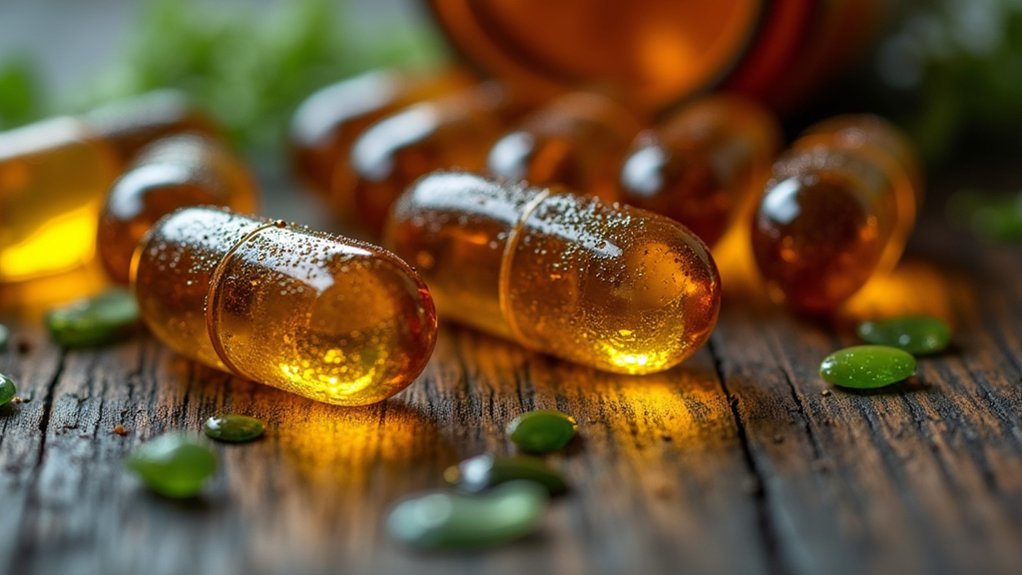
While EPA and DHA deliver powerful health benefits, these omega-3 fatty acids possess an Achilles’ heel that threatens their effectiveness: extreme vulnerability to oxidation.
You’re dealing with highly unstable compounds that deteriorate rapidly when exposed to environmental factors. Temperature proves particularly damaging—oxidation doubles with each 10°C rise, meaning your fish oil degrades twice as fast in warm conditions.
Light exposure accelerates this breakdown through photo-oxidation, while oxygen contact triggers chemical reactions that form harmful peroxides and other oxidation products.
These reactions don’t just reduce potency; they create rancid odors and flavors that make your supplements unpalatable. The highest peroxide value recorded in studies reaches 1.45 meq O/kg, demonstrating measurable oxidative damage even under controlled conditions.
Without proper protection, your EPA and DHA supplements lose their therapeutic value and become potential sources of oxidative stress rather than health benefits.
How Multiple Double Bonds Create Oxidation Risk
The molecular architecture of EPA and DHA creates their vulnerability problem—each omega-3 fatty acid contains multiple double bonds that act like chemical targets for oxidative attack.
EPA contains five double bonds while DHA has six, making both molecules highly reactive when exposed to oxygen. These double bonds serve as initiation points where oxygen molecules attach, forming hydroperoxides that quickly decompose into free radicals.
The abundance of double bonds in EPA and DHA creates multiple vulnerability points where oxygen can trigger destructive chain reactions.
Once started, this oxidation spreads through chain reactions, attacking additional double bonds throughout your fish oil. Light, heat, and even trace oxygen accelerate this process, explaining why your supplements can turn rancid even under seemingly proper storage conditions. The resulting oxidation products may have altered biological activity, potentially rendering your supplements ineffective or harmful.
More double bonds simply mean more vulnerability points for oxidative damage.
Free Radical Chain Reactions in Fish Oil Degradation
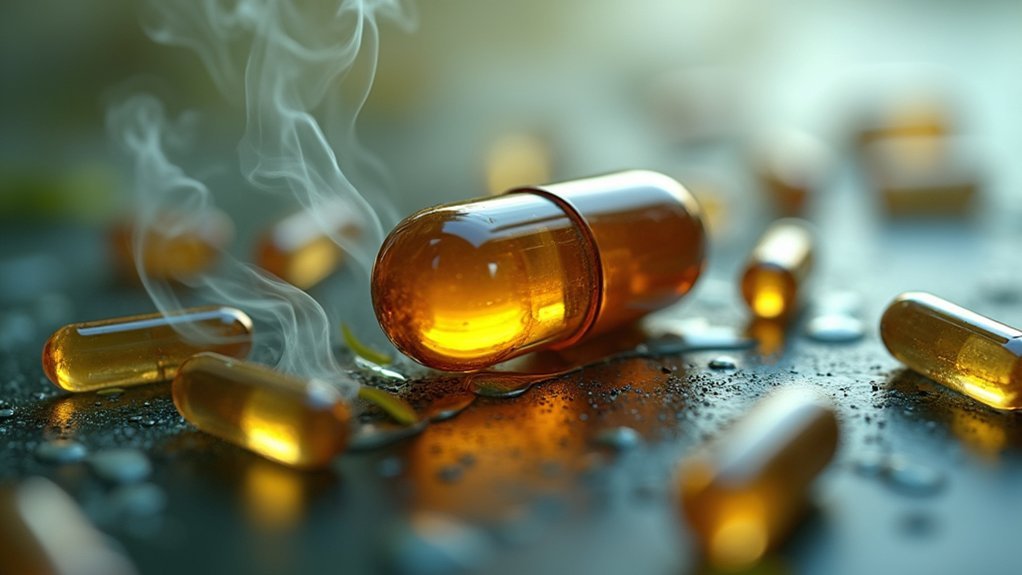
Once oxidation begins at those vulnerable double bonds, fish oil degradation transforms into a destructive cascade that’s nearly impossible to stop. You’re witnessing a free radical chain reaction with three distinct phases that systematically destroy your fish oil’s potency.
| Phase | Process | Impact |
|---|---|---|
| Initiation | Free radicals abstract hydrogen from bis-allylic positions | Creates first lipid radicals |
| Propagation | Lipid radicals form hydroperoxides (LOOH) | Chain reaction amplifies damage |
| Termination | LOOH decomposes into volatile compounds | Rancidity and potency loss |
During propagation, each lipid radical you’ve created generates more radicals, exponentially accelerating degradation. DHA’s six double bonds make it especially vulnerable compared to EPA’s five. The result? Your valuable omega-3s transform into harmful compounds that not only smell terrible but also lose their beneficial properties entirely.
This destructive process can occur even at room temperature, making proper storage conditions absolutely critical for maintaining fish oil quality and preventing the rapid deterioration of these sensitive polyunsaturated fatty acids.
Temperature’s Role in Accelerating Potency Loss
Every 10°C rise in temperature roughly doubles the rate at which your fish oil degrades, making heat one of the most destructive forces threatening your supplement’s potency.
Even at relatively low temperatures like 50°C, EPA concentration drops dramatically from 6.1% to just 2.2%. You’ll face significant oxidation within a month, even when storing your supplements at 4°C.
Even refrigerated fish oil supplements face significant oxidation within just one month of storage.
Room temperature storage accelerates this degradation process, particularly in retail environments where temperature fluctuations are common. Heat exposure combined with direct sunlight creates the most damaging storage conditions for your supplements.
Your omega-3 fatty acids are especially vulnerable because they require less energy for H-atom abstraction compared to saturated fats. This creates more conjugated dienes and lipid peroxides, destroying the beneficial compounds you’re paying for.
Refrigeration becomes essential for preserving potency.
Oxygen Exposure as the Primary Cause of Rancidity
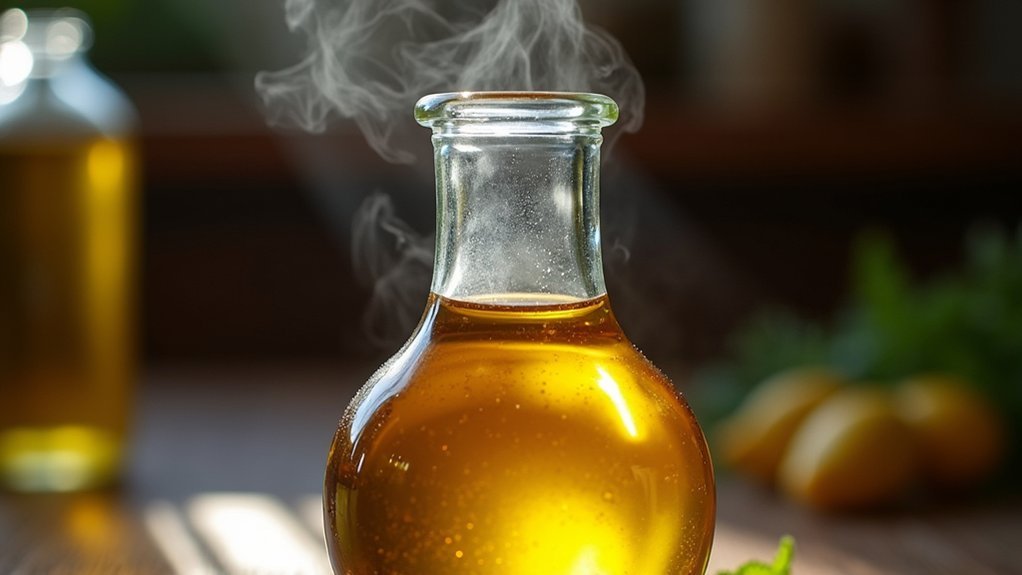
While heat accelerates fish oil degradation, oxygen exposure stands as the primary culprit behind rancidity development in your omega-3 supplements.
When oxygen contacts EPA and DHA fatty acids, it breaks down their chemical bonds and creates harmful compounds like peroxides, aldehydes, and alcohols. These oxidation products produce that unmistakable fishy taste and smell you’ve likely encountered.
Your omega-3s become particularly vulnerable because their multiple double bonds react readily with oxygen.
This oxidation doesn’t just affect taste—it reduces the oils’ biological activity and nutritional value while potentially creating toxic compounds that may harm your health. Longer storage durations consistently correlate with increased oxidation rates and greater deterioration of supplement quality.
- Chemical bonds break down when oxygen contacts unsaturated fatty acids
- Peroxides, aldehydes, and alcohols form as harmful oxidation products
- Multiple double bonds make omega-3s especially susceptible to oxygen damage
- Biological activity and nutritional benefits decrease considerably
- Toxic compounds can develop, posing potential health risks
Light and Humidity Effects on Omega-3 Stability
Beyond oxygen exposure, light and humidity create additional threats to your fish oil’s stability and potency.
Light accelerates lipid oxidation by converting atmospheric oxygen to reactive singlet oxygen, which directly attacks omega-3 fatty acids. Both UV and visible light trigger this process, while photosensitizers like riboflavins enhance oxidation rates.
Humidity compounds these problems. Even trace water amounts facilitate pro-oxidant activity and accelerate oxidation at oil-water interfaces. Free fatty acids act as surfactants, increasing oxygen transfer and speeding degradation.
Water also helps decompose hydroperoxides into harmful secondary compounds.
These factors work synergistically, rapidly degrading EPA and DHA while forming potentially toxic aldehydes.
You’ll need dark, opaque containers and low-humidity storage to protect your fish oil’s potency and safety.
Measuring Fish Oil Freshness Through Oxidation Markers
You can’t determine your fish oil’s quality by appearance alone—you’ll need specific oxidation tests to measure freshness accurately.
These standardized methods detect primary and secondary oxidation products that directly correlate with your supplement’s potency and safety. Advanced techniques like SIFT-MS can identify volatile aldehydes and other oxidation markers that form as fish oils deteriorate over time.
Understanding how to interpret test results like peroxide values and TOTOX scores helps you make informed decisions about whether your fish oil is still effective or has deteriorated beyond acceptable limits.
Common Oxidation Test Methods
Since fish oil’s high polyunsaturated fatty acid content makes it particularly vulnerable to oxidation, manufacturers and consumers rely on specific testing methods to evaluate freshness and quality.
These standardized tests help you determine whether your fish oil supplements maintain their potency and safety.
Several industry-proven methods assess different stages of oxidation:
- Peroxide Value (PV) – Measures peroxides formed during initial oxidation stages
- Para-Anisidine Value (pAV) – Detects secondary oxidation products and aldehydes
- Total Oxidation (TOTOX) – Combines PV and pAV for thorough oxidation assessment
- SIFT-MS Technology – Rapidly identifies volatile oxidation markers through mass spectrometry
- Sensory Testing – Evaluates characteristic off-flavors and rancid odors
These methods follow established AOCS protocols and GOED standards, ensuring consistent results across laboratories and manufacturing facilities.
GOED has established maximum limits for PV and pAV in EPA and DHA oils that are stricter than those applied to other edible oils, with specific thresholds designed to maintain omega-3 supplement quality.
Interpreting Freshness Quality Results
Understanding what those test numbers actually mean determines whether your fish oil supplement meets quality standards or poses potential health risks.
When you’re reading your fish oil’s Certificate of Analysis, you’ll see specific oxidation markers with recommended limits. The Peroxide Value (PV) should stay below 5 mEq/kg according to GOED standards, though stricter manufacturers like EPAX set limits under 3 mEq/kg.
Your Anisidine Value (AV) shouldn’t exceed 20, indicating minimal secondary oxidation damage. The Total Oxidation (TOTOX) value combines both measurements and should remain below 26.
Additionally, check that the Acid Value stays under 3 mg KOH/g—higher numbers signal rancidity. Remember that peroxide values may actually decrease over time while anisidine values continue to increase, making both measurements essential for accurate freshness assessment.
These industry standards from CRN, GOED, and IFOS help you identify quality products that won’t compromise your health through harmful oxidative compounds.
Linking Markers to Potency
When fish oil oxidizes, it doesn’t just smell bad—it loses its therapeutic power. You need to understand how oxidation markers directly correlate with your supplement’s effectiveness. As peroxide and anisidine values climb, the biological activity of omega-3 fatty acids diminishes, compromising the health benefits you’re seeking.
Research shows that oxidized fish oil exhibits altered molecular structures that reduce its anti-inflammatory properties. Your body can’t utilize degraded omega-3s as effectively as fresh ones. This is why TOTOX values matter—they’re not just quality indicators but potency predictors. Studies reveal that 50% of OTC products exceed recommended oxidation markers, highlighting widespread quality issues across the supplement market.
Key relationships between oxidation and potency:
- Higher TOTOX values correlate with reduced omega-3 bioavailability
- Oxidized oils show decreased anti-inflammatory effects in studies
- Fresh oils with TOTOX ≤5 maintain ideal therapeutic benefits
- Secondary oxidation products interfere with cellular absorption
- Quality markers directly predict supplement effectiveness
The Gap Between Label Claims and Actual Potency
You might assume the EPA and DHA amounts on your fish oil label reflect what’s actually in the bottle, but oxidation can greatly reduce these levels over time.
Storage conditions like heat and light exposure don’t just affect freshness—they actively degrade the omega-3 content you’re paying for. Testing by Consumer Reports found that all labeled amounts of EPA and DHA were present in the brands they evaluated.
This creates a troubling gap where your supplement may contain far less EPA and DHA than what’s printed on the package.
Oxidation Reduces EPA/DHA
Although fish oil labels promise specific amounts of EPA and DHA, oxidation silently erodes the actual potency of these critical omega-3 fatty acids long before you open the bottle.
When fish oil oxidizes, it doesn’t just develop that fishy smell—it undergoes fundamental chemical changes that reduce the effectiveness of EPA and DHA. The oxidation process forms lipid peroxides that further break down into secondary compounds like aldehydes, creating a cascade of chemical alterations. Distinct fish oils exposed to different oxidizing conditions yield unique profiles of harmful oxidation products.
Key ways oxidation reduces EPA/DHA potency:
- Chemical composition changes – Original fatty acid profiles become altered through oxidative breakdown
- Lipid peroxide formation – Initial oxidation creates compounds that accelerate further degradation
- Secondary product development – Aldehydes and volatile compounds replace beneficial omega-3s
- Reduced bioavailability – Oxidized fatty acids become less effective in your body
- Progressive deterioration – Potency continues declining throughout storage and shelf life
Misleading Label Accuracy
Fish oil manufacturers routinely print EPA and DHA amounts on their labels that don’t match what’s actually inside the bottle, creating a significant gap between promised potency and delivered results.
You’ll find many supplements include health claims for cardiovascular, brain, joint, and eye health that aren’t supported by clinical data. These structure/function claims often use vague language that implies benefits without scientific evidence, misleading you about what you’re actually getting.
Industry-standard testing frequently reveals discrepancies between labeled and actual content.
While certification programs like IFOS help verify quality standards for over 200 brands worldwide, current regulations don’t adequately address claim accuracy. Third-party validation builds consumer trust and confidence by ensuring the product quality claims are independently verified.
You can’t rely on labels alone—look for third-party testing and certification to guarantee you’re getting the potency you’re paying for.
How Storage Duration Impacts Bioactive Compound Levels
When you store fish oil for extended periods, the bioactive compounds that make it valuable begin to deteriorate through a process primarily driven by lipid oxidation.
This degradation occurs most rapidly during the first few months of storage, causing a significant decrease in potency over time. The formation of secondary oxidation products accelerates this process, reducing your fish oil’s effectiveness. Research shows that proper storage conditions can significantly extend the shelf life, with unopened oils lasting 1-2 years while opened oils maintain quality for 3-8 months when refrigerated.
Key bioactive compounds affected by storage duration include:
- Omega-3 fatty acids – Essential for potency but highly sensitive to oxidation
- Resolvins and protectins – Pro-resolving mediators that degrade without proper preservation
- Phenolic compounds – Natural antioxidants that diminish over time
- Tocopherols – Vitamin E compounds that protect other nutrients but deplete during storage
- EPA and DHA concentrations – Critical fatty acids that decrease as oxidation progresses
Proper Packaging Methods to Preserve Omega-3 Quality
Understanding how time degrades fish oil’s valuable compounds highlights why proper packaging becomes your first line of defense against oxidation and potency loss.
Proper packaging serves as your essential shield against time’s relentless assault on fish oil’s delicate therapeutic compounds.
You’ll find amber glass containers offer superior protection by blocking harmful UV light that accelerates degradation. Dark, non-transparent packaging minimizes light exposure better than clear alternatives.
Encapsulation creates a physical barrier against oxygen, with nanoemulsion techniques providing enhanced protection through emulsifier-coated oil droplets.
These capsulated forms show markedly higher stability than non-encapsulated versions.
You should prioritize packaging that minimizes headspace in liquid containers and guarantees tight sealing after opening. Individual hard capsule packing prevents contamination from broken capsules while reducing exposure to oxygen compared to traditional soft gel packaging methods.
Single-use formats like stick packs reduce air exposure, while oxygen absorbers and vacuum-sealed packaging provide additional protection against oxidative damage.
Natural Antioxidants and Preservatives for Enhanced Stability
While packaging protects fish oil from external threats, natural antioxidants work from within to combat the oxidative processes that degrade omega-3 fatty acids at the molecular level.
You’ll find that natural preservatives like tocopherols and rosemary extracts act as free radical scavengers, neutralizing the compounds that cause lipid peroxidation. These options are increasingly preferred over synthetic alternatives like BHT because they align with consumer demands for healthier, more sustainable products. Microencapsulation techniques have emerged as an innovative approach to enhance fish oil stability, with whey protein concentrate and soybean protein particles providing additional protective barriers against oxidation.
- Tocopherols and rosemary extracts effectively stabilize fish oils by preventing lipid oxidation
- Sesamol and oryzanol serve as natural alternatives to synthetic BHT preservatives
- Pomegranate, açai berry, and grape seed extracts show promise in reducing oxidative damage
- Storage conditions including temperature, moisture, and time affect antioxidant performance
- Combining multiple antioxidants enhances preservation effects beyond single-type applications
Optimal Storage Conditions for Maximum Potency Retention
Beyond selecting fish oil with robust antioxidant protection, you’ll need to create storage conditions that preserve those omega-3 fatty acids from the moment you bring the product home.
Store opened liquid fish oil in your refrigerator at 35–40°F to slow oxidation and maintain potency. Keep capsules in cool, dry places away from heat-emitting appliances, as temperatures above 75°F accelerate rancidity.
Shield all forms from direct sunlight using original dark packaging or opaque containers—light exposure degrades omega-3s through photo-oxidation. Tightly reseal containers after each use to limit oxygen contact, which causes spoilage. When fish oil oxidizes, it forms harmful aldehydes that can negate the supplement’s health benefits.
Control humidity with proper sealing, especially in refrigerated storage where condensation threatens product integrity. These conditions greatly extend your fish oil’s shelf life and therapeutic value.
Consumer Strategies for Identifying High-Quality Fish Oil
You can protect your investment in fish oil supplements by learning to spot quality indicators before making a purchase.
Understanding how to test for freshness markers and decode label claims will help you choose products that deliver their promised potency. Modern testing methods can quickly check oxidation state without requiring toxic solvents for analysis.
These simple evaluation techniques guarantee you’re getting the maximum health benefits from your omega-3 supplement.
Testing Freshness Markers
When you’re shopping for fish oil supplements, understanding freshness markers empowers you to identify high-quality products that’ll deliver peak health benefits.
These scientific measurements reveal oxidation levels that directly impact potency and safety.
The TOTOX value combines peroxide and anisidine measurements into a single freshness score. Look for values below 26.0 meq/kg, though premium brands often score much lower.
Peroxide values indicate initial rancidity, while anisidine values detect secondary oxidation that causes rancid odors and tastes. Reputable manufacturers should provide third-party test results showing these freshness values on their company website or via email request.
- TOTOX Value: Combined oxidation score should be below 26.0 meq/kg
- Peroxide Value: Measures primary oxidation and initial rancidity stages
- Anisidine Value: Detects secondary oxidation causing rancid smell/taste
- Total Acid Value: Indicates microbial degradation and poor quality
- Sensory Test: Trust your nose—rancid odors signal high oxidation
Reading Label Claims
Fish oil labels contain a maze of claims that can mislead even savvy consumers. You’ll encounter structure/function claims like “supports joint health,” but these can’t legally state the product treats disease.
The FDA has approved only two qualified health claims for fish oil—covering heart disease and blood pressure—with qualifying language reflecting scientific uncertainty.
Focus on verified information rather than marketing promises. Look for labels clearly stating fish species, EPA/DHA concentrations, and omega-3 form (triglycerides or ethyl esters).
International standards require at least 27% EPA/DHA for basic fish oils and 50% for concentrated versions.
Most importantly, over 70% of tested supplements don’t contain their labeled omega-3 amounts. Consumer Lab analyses have revealed that some products contained 20-30% less than their claimed amounts. Prioritize brands with third-party verification and published batch-specific test results.
Shelf Life Management for Therapeutic Omega-3 Benefits
While omega-3 fatty acids provide significant therapeutic benefits, their potency depends entirely on proper shelf life management from the moment you purchase your fish oil supplement.
You’ll maximize EPA and DHA content by consuming fish oil within its recommended timeframe and storing it correctly. Oxidation directly reduces these essential fatty acids’ therapeutic value, diminishing anti-inflammatory properties and cardiovascular benefits.
Your dosage management strategy should include:
- Consuming opened bottles within 3-8 months for peak potency
- Refrigerating liquid fish oil immediately after opening
- Storing capsules in cool, dark places away from heat sources
- Following manufacturer expiration dates strictly
- Checking for spoilage signs like off odors or color changes
Quality control through proper shelf life management guarantees you receive fish oil’s full therapeutic potential rather than degraded, less effective supplements. Taking fish oil with dietary fat enhances absorption and maximizes the bioavailability of omega-3 fatty acids.
Frequently Asked Questions
Can Oxidized Fish Oil Cause Harmful Side Effects or Health Risks?
Yes, you’ll face serious health risks from oxidized fish oil. You can experience liver damage, kidney enlargement, anemia, vitamin E depletion, cardiovascular inflammation, and increased atherosclerosis risk from consuming rancid supplements regularly.
How Do Fish Oil Manufacturing Processes Affect Initial Product Quality?
Manufacturing processes directly impact your fish oil’s quality through extraction methods, purification techniques, and quality control measures. Poor processing can reduce omega-3 content, increase oxidation, and leave harmful contaminants in the final product.
Is Liquid Fish Oil More Prone to Oxidation Than Capsules?
You’ll find liquid fish oil oxidizes faster than capsules since it’s more exposed to oxygen and light. However, capsules can mask rancidity signs, making it harder for you to detect when they’ve gone bad.
Do Higher Epa/Dha Concentrations Make Supplements More Oxidation-Resistant?
Higher EPA/DHA concentrations don’t make your supplements more oxidation-resistant. You’ll actually find they’re more susceptible to oxidation because increased unsaturation levels create more vulnerable sites for free radical attacks.
Can Refrigerated or Frozen Fish Oil Extend Potency Beyond Expiration Dates?
You can’t extend fish oil’s potency beyond its expiration date through refrigeration or freezing. While cold storage slows oxidation, it doesn’t eliminate spoilage risk or restore lost nutrients.
In Summary
You’ll maximize your fish oil’s therapeutic benefits by storing it properly and choosing high-quality products. Keep your supplements refrigerated, away from light and air exposure, and always check expiration dates before purchasing. Don’t ignore signs of rancidity like fishy odors or taste. You’re investing in your health, so protect that investment by understanding how temperature, oxygen, and time affect your omega-3’s potency and effectiveness.

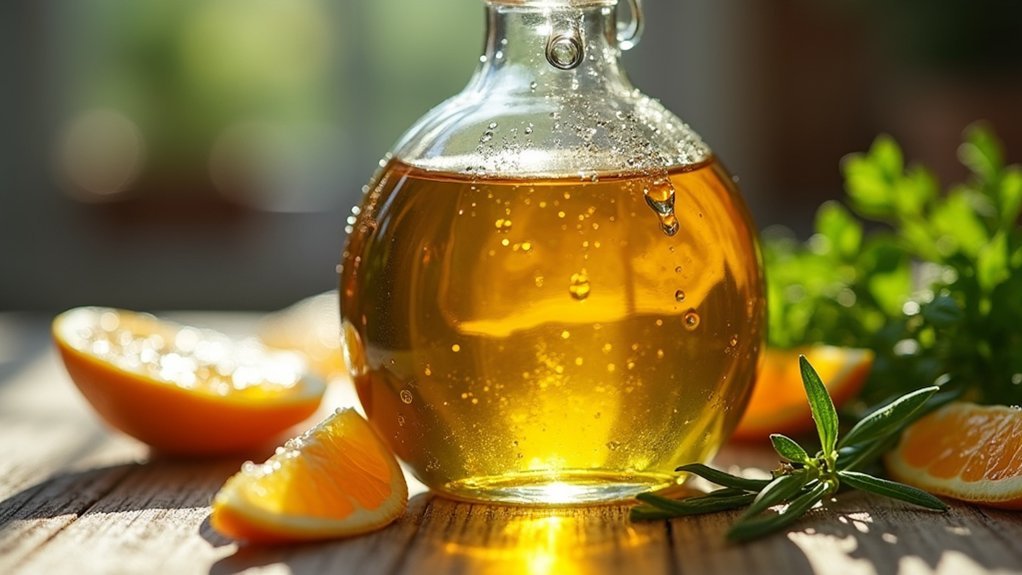
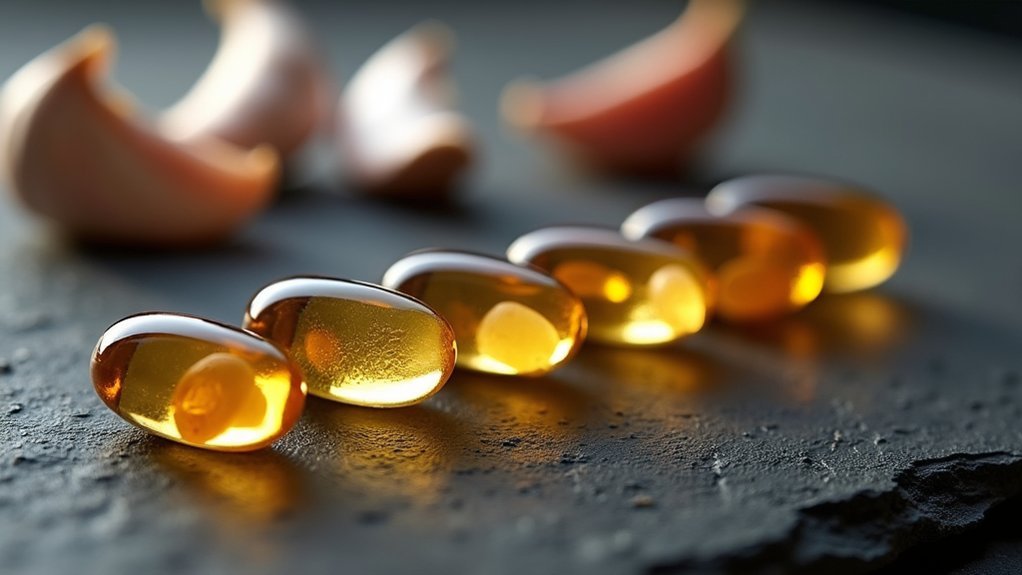


Leave a Reply